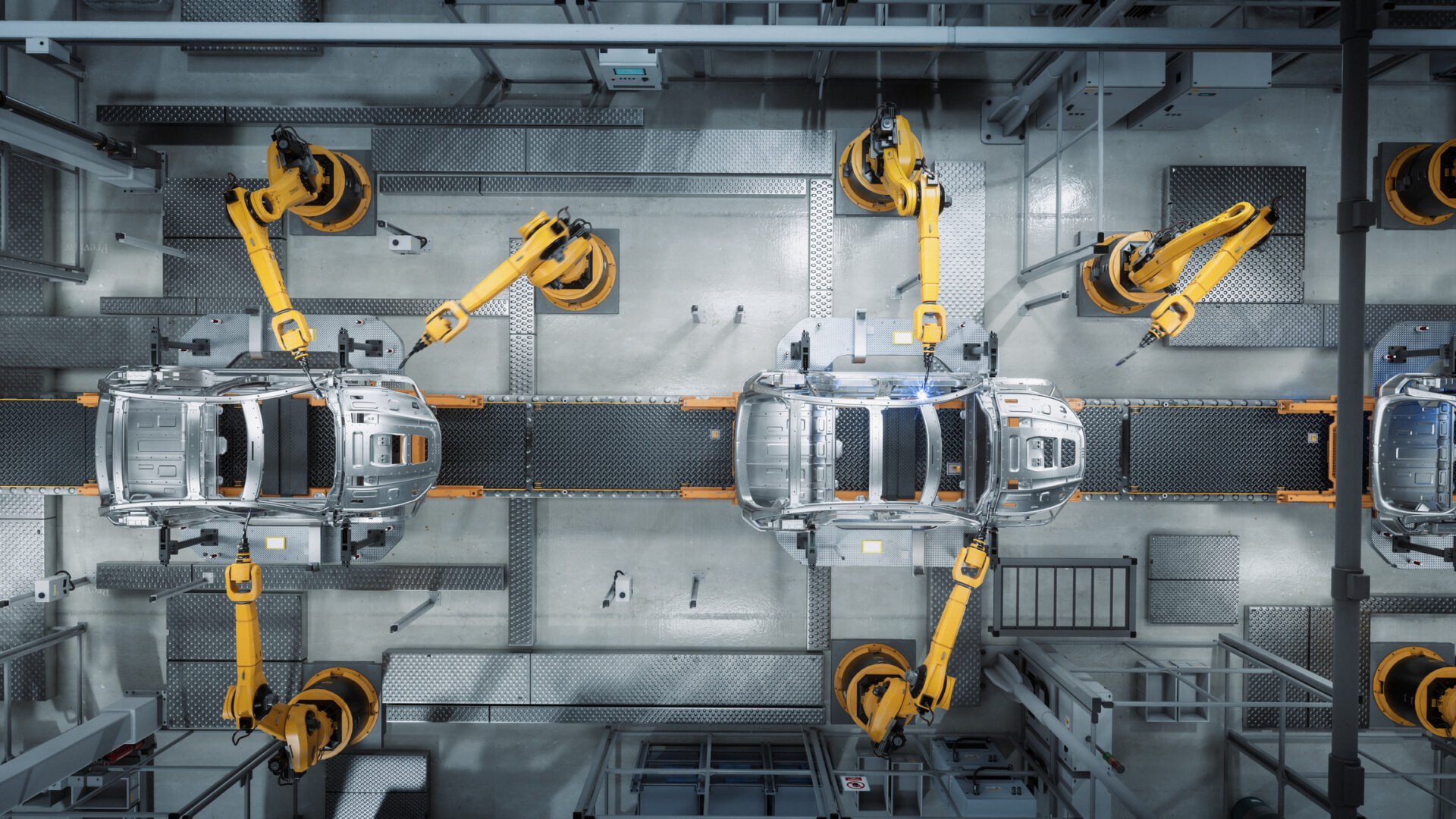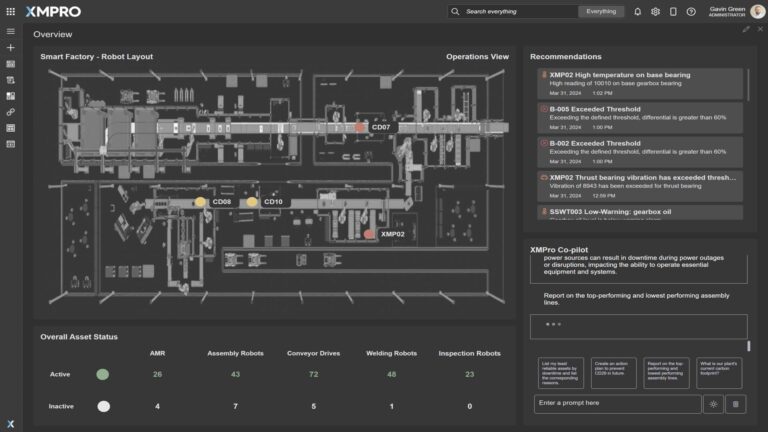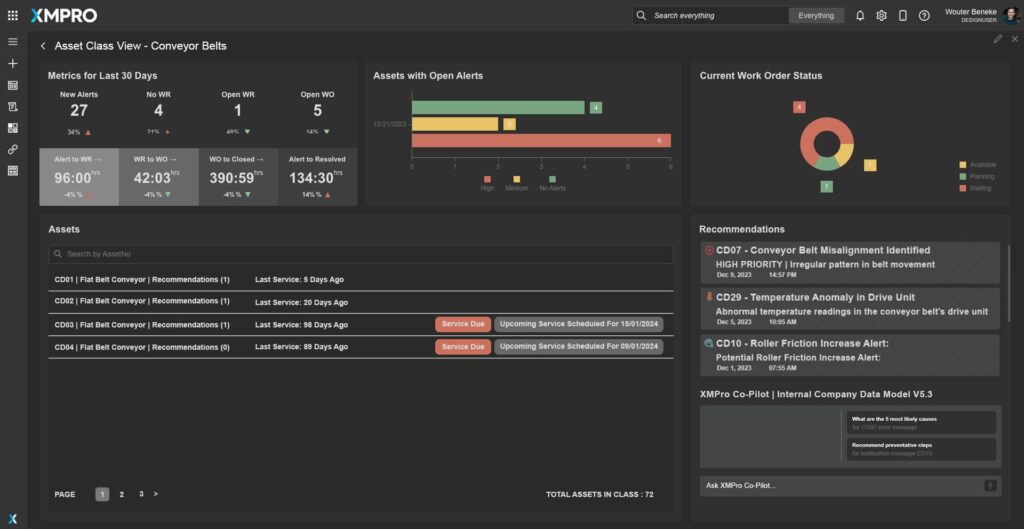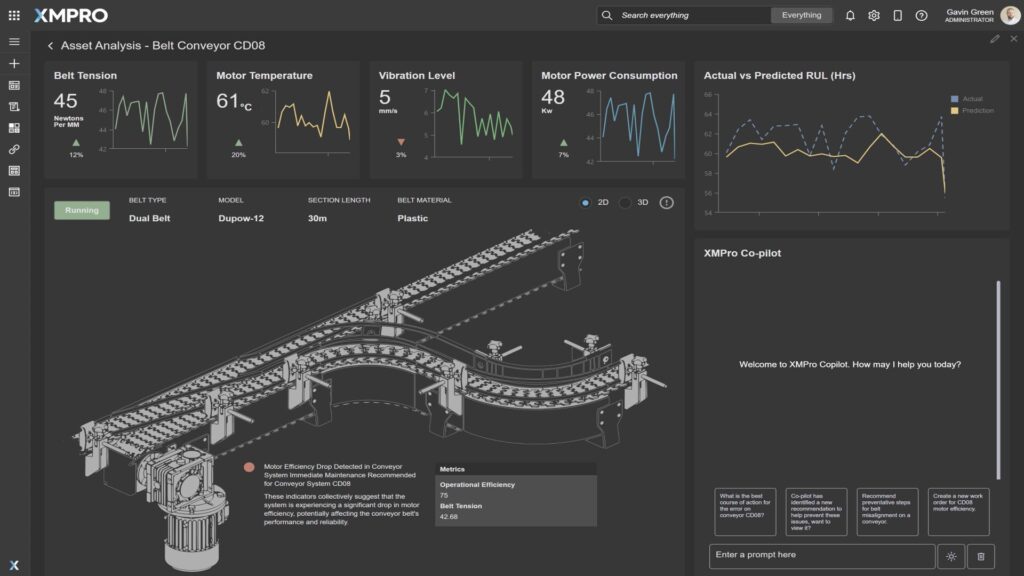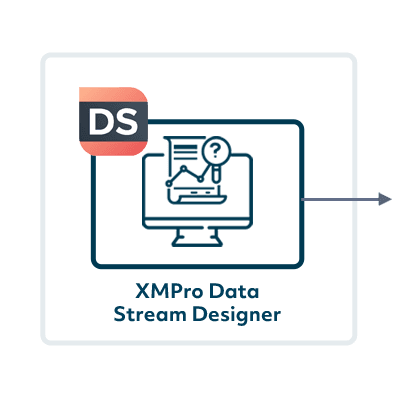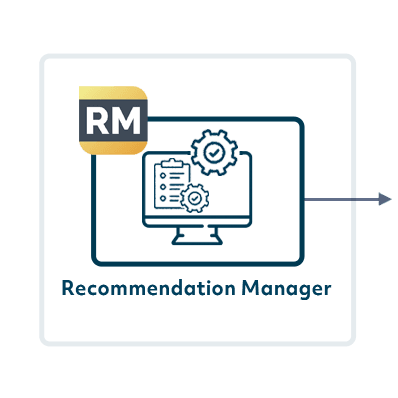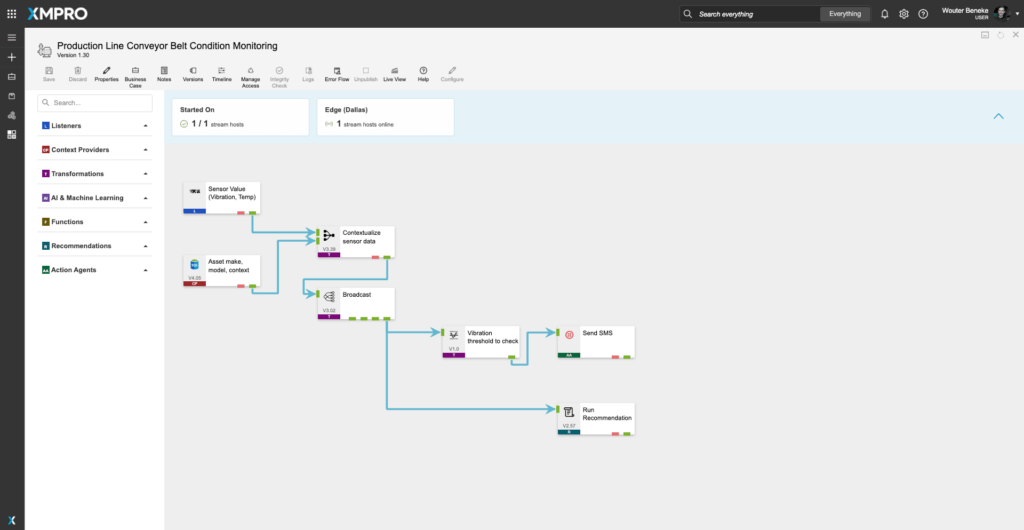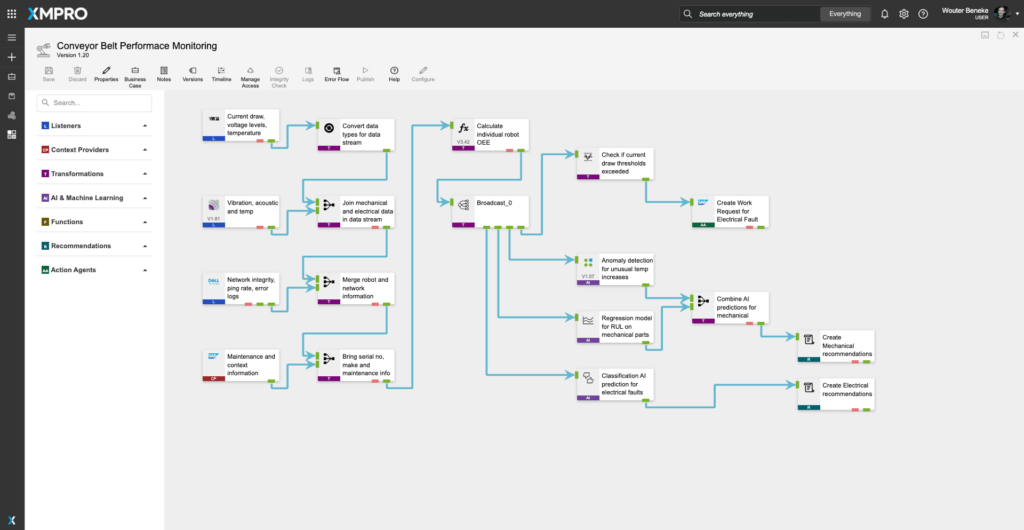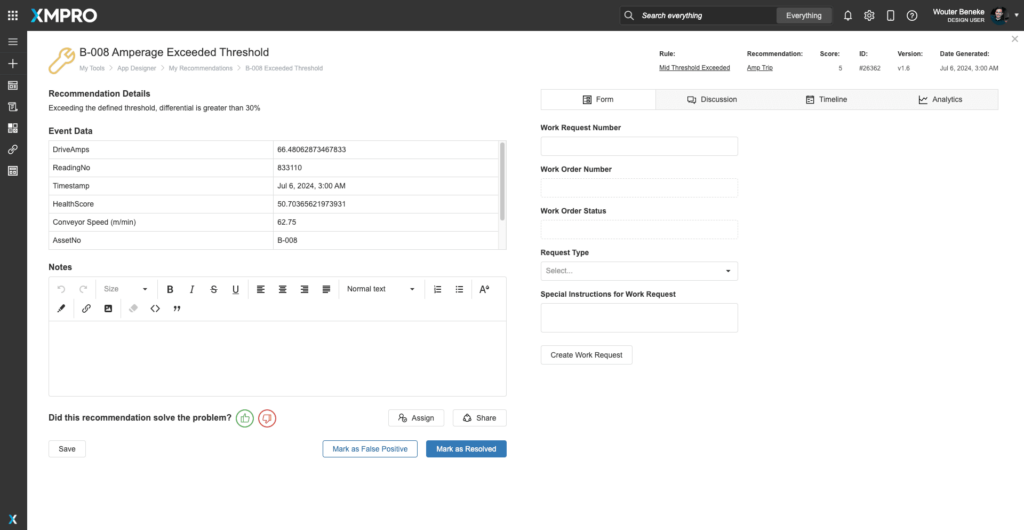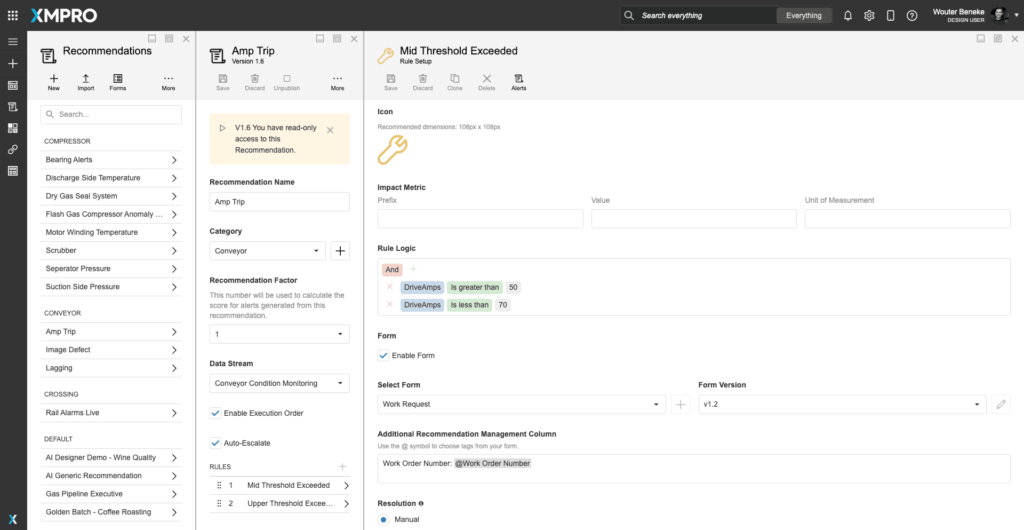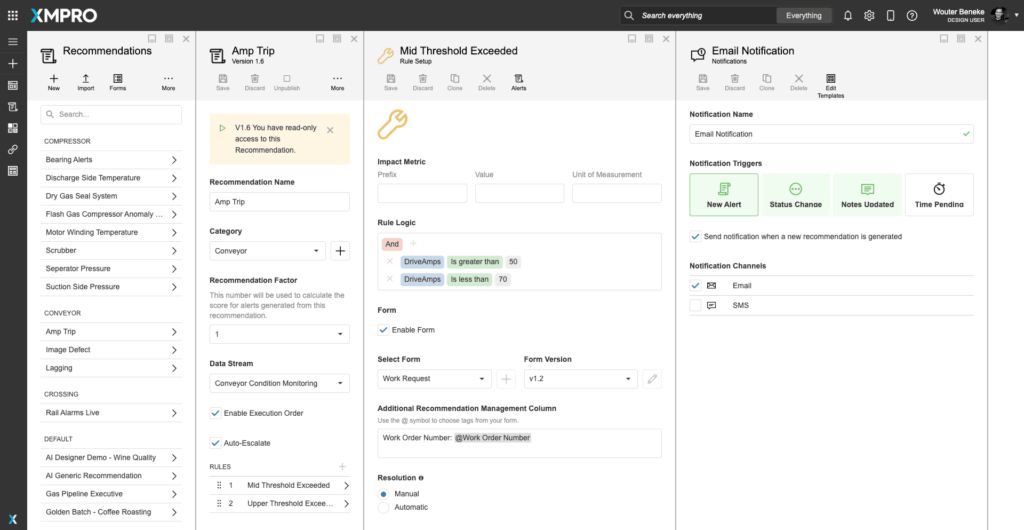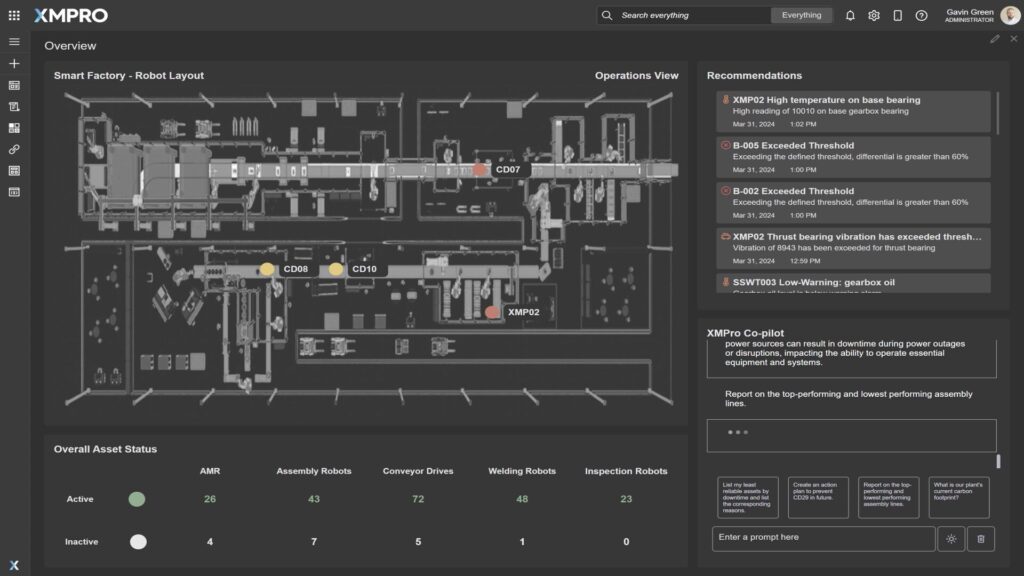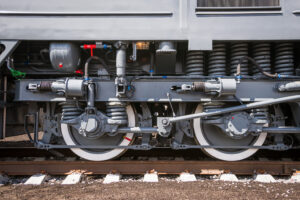Conveyor Belt System Monitoring and Optimization in Automotive Manufacturing
Introduction
In the automotive manufacturing industry, conveyor belt systems are vital for the seamless movement of components and assemblies. Their efficiency directly impacts the overall production process. XMPro’s Intelligent Business Operations Suite offers a sophisticated solution for monitoring and optimizing these systems, ensuring uninterrupted and efficient operation.
The Challenge
Conveyor belt systems in automotive manufacturing face several significant challenges:
Wear and Tear: Continuous operation leads to the deterioration of belts, motors, and rollers, which can result in unexpected failures and costly downtime.
Unpredictable Failures: Traditional maintenance schedules based on fixed intervals may not accurately predict the actual wear and tear, leading to either premature maintenance or delayed interventions that can result in equipment failure and production stoppages.
Operational Inefficiencies: Inefficiencies in conveyor system operations, such as improper belt alignment or variable speed issues, can go unnoticed without real-time monitoring, affecting the overall productivity and quality of the manufacturing process.
Energy Consumption: Conveyor systems can be significant energy consumers in the manufacturing process. Without optimization, they can lead to increased operational costs and a larger carbon footprint.
The Solution: XMPro iBOS for Conveyor Belt System Monitoring & Optimization
XMPro’s Intelligent Business Operations Suite (iBOS) enhances conveyor belt efficiency and reliability in automotive manufacturing through continuous real-time IoT monitoring, enabling early issue detection and reduced downtime. Advanced predictive analytics predict failures and optimize maintenance, improving system reliability and lifespan. The digital twin feature allows for virtual failure analysis and operational adjustments, optimizing maintenance without disrupting production. Automated alerts and recommendations ensure quick responses, while efficient maintenance scheduling minimizes downtime and extends component life. Additionally, operational efficiency and energy consumption analysis lead to cost savings and better production efficiency, supporting sustainable practices.
Real-Time Monitoring with IoT Integration: XMPro iBOS integrates existing IoT sensors for continuous monitoring of conveyor system parameters. This proactive approach helps in early detection of issues, preventing unexpected failures and reducing downtime. The key benefit is maintaining consistent production flow by addressing problems before they escalate.
Advanced Predictive Analytics: The suite utilizes machine learning to analyze sensor data, predicting potential failures and optimal maintenance times. This shift to predictive maintenance enhances system reliability and extends its lifespan, moving away from less efficient reactive maintenance models.
Digital Twin Simulation for Conveyor: XMPro iBOS creates a digital twin of the conveyor system, allowing for failure scenario analysis and operational adjustments in a virtual environment. This capability enables testing and optimization of maintenance strategies without impacting production, leading to improved system performance.
Automated Alerts and Maintenance Recommendations: The system generates automated alerts for potential issues and provides targeted maintenance recommendations. This feature ensures quick and effective maintenance responses, improving system uptime and reducing response times for maintenance teams.
Maintenance Scheduling Optimization: Maintenance tasks are efficiently scheduled based on urgency and impact, optimizing resource allocation. This approach minimizes downtime and extends the lifespan of conveyor components, ensuring a more effective maintenance process.
Operational Efficiency and Energy Consumption Analysis: XMPro iBOS analyzes data to identify improvements in conveyor speed and energy use, enhancing overall system efficiency. This leads to cost savings, reduced environmental impact, and better production efficiency, aligning with sustainable manufacturing practices.
How XMPro iBOS Modules Work Together To Create This Condition Monitoring Solution

XMPro Data Stream Designer
XMPRO’s Data Stream Designer lets you visually design the data flow and orchestration for your real-time applications. Our drag & drop connectors make it easy to bring in real-time data from a variety of sources, add contextual data from systems like EAM, apply native and third-party analytics and initiate actions based on events in your data.
Figure 1. Conveyor Belt Condition Monitoring Data Stream
This conveyor belt condition monitoring data stream begins by ingesting sensor values for vibration and temperature, then contextualizes this data with asset make, model, and operational context. The contextualized data is broadcasted and checked against a vibration threshold. If the threshold is exceeded, an SMS notification is sent. Additionally, the system runs a recommendation to assess the condition further and suggest necessary actions, ensuring comprehensive monitoring and timely maintenance responses.
Figure 2. Conveyor Belt Performance Monitoring Data Stream
This conveyor belt performance monitoring data stream collects current draw, voltage levels, temperature, vibration, acoustic, and network integrity data. The data is converted and joined to provide a comprehensive view, including mechanical and electrical aspects. Calculations are performed to assess operational efficiency, and anomaly detection identifies unusual temperature increases. AI models predict remaining useful life and classify potential electrical faults. The system generates work requests for identified faults and creates detailed mechanical and electrical recommendations, ensuring proactive maintenance and efficient performance management.

Recommendation Manager
XMPRO Recommendations are advanced event alerts that combine alerts, actions, and monitoring. You can create recommendations based on business rules and AI logic to recommend the best next actions to take when a certain event happens. You can also monitor the actions against the outcomes they create to continuously improve your decision-making.
Figure 1. Amperage Exceeded Threshold Recommendation
This recommendation identifies that the amperage for the motor on conveyor drive B-008 has exceeded the defined threshold by more than 30%. The event data includes details such as drive amps, reading number, timestamp, health score, conveyor speed (measured in meters per minute), and asset number. Users can add notes, assign the recommendation, share it, and create a work request with special instructions. The system tracks whether the recommendation solved the problem and provides options to mark it as a false positive or resolved. This setup ensures timely response to motor issues on the conveyor drive by providing detailed event data and facilitating immediate action through work requests and documentation.
Figure 2. Configure With Granular Rule Logic
This recommendation for an “Amp Trip” on a conveyor monitors when the drive amps exceed defined thresholds. The rule logic is set to trigger when the drive amps are greater than 50 and less than 70. When this threshold is exceeded, the system can take various actions, including sending notifications via email or SMS, automatically creating work orders, sending information to ERPs, and executing other predefined actions. This ensures comprehensive monitoring and immediate response to conveyor issues, facilitating seamless integration and proactive maintenance actions. The recommendation includes fields for event data, notes, and work request creation, ensuring that all necessary information is captured and acted upon promptly.
Figure 3. Close The Loop On Event Response
Closing the loop on event response, the system can take various actions, including sending email and SMS notifications for new recommendations, status changes, note updates, and pending times. Additionally, it can automatically create work orders, send information to ERPs, and execute other predefined actions, ensuring comprehensive monitoring and immediate response to pump issues with detailed guidance and timely alerts.
XMPro App Designer
The XMPro App Designer is a no code event intelligence application development platform. It enables Subject Matter Experts (SMEs) to create and deploy real-time intelligent digital twins without programming. This means that SMEs can build apps in days or weeks without further overloading IT, enabling your organization to accelerate and scale your digital transformation.
Figure 1. Real-Time Conveyor Belt System Overview Dashboard for Automotive Assembly Lines
This advanced dashboard is specifically designed for operators in automotive manufacturing, offering a comprehensive view of conveyor belt system performance in assembly lines. It features an interactive layout of the factory floor, dynamically updating with the operational status of different conveyor belt systems, providing a clear visual representation of their efficiency and health.
Overview of Conveyor Belt System Health:
The dashboard displays the overall performance status of conveyor belt systems, highlighting areas with potential efficiency issues or optimization opportunities. It includes critical alerts such as belt misalignment, speed variances, and maintenance alerts for components like motors and rollers.
Performance Optimization Alerts:
Utilizing data from integrated sensors and advanced analytics, the dashboard provides real-time insights into optimization opportunities. It highlights conveyor systems requiring adjustments for issues like belt tension discrepancies or speed inefficiencies.
Maintenance Planning and Scheduling:
A detailed graph tracks maintenance and performance optimization requirements across the conveyor systems. It prioritizes systems based on their needs for maintenance or performance adjustments, facilitating efficient and proactive scheduling.
Drill-Down Capability for In-Depth Analysis:
Users can explore specific conveyor systems for detailed information, including historical performance data, recent maintenance activities, and predictive maintenance recommendations. This level of detail enables targeted actions based on the system’s predictive analytics.
Customizable Alerts and Recommendations:
The dashboard highlights active recommendations generated by the system’s smart rule logic and machine learning algorithms. This includes suggestions for enhancing conveyor system performance, addressing wear and tear issues, and other optimization actions.
Overall Asset Status Summary:
At the bottom of the screen, there’s a summary of the status of different conveyor systems, including the number of active and inactive units across various assembly lines.
Search Functionality:
A search bar at the top allows users to search for specific data across the platform.
This Real-Time Conveyor Belt System Performance Optimization Dashboard is an essential tool for automotive manufacturing operators, enabling them to effectively monitor and optimize the performance of their conveyor belt systems. By providing real-time data, predictive insights, and actionable recommendations, it ensures informed decision-making and enhances the operational efficiency and productivity of the assembly lines.
Figure 2. Asset Drill Down View – Conveyor Belt Systems in Automotive Assembly
This specialized dashboard for conveyor belt systems in automotive assembly lines offers a comprehensive and actionable overview, essential for maintaining high production standards and efficiency.
Alerts Overview
The dashboard features a graphical representation of open alerts on conveyor belt systems, categorized by severity (no alerts, medium, high). This categorization is crucial for the immediate identification and prioritization of critical issues. The key benefit is the enhancement of responsiveness to potential problems, preventing their escalation into more significant failures. By addressing medium and high-severity alerts promptly, maintenance teams can resolve issues before they impact production, ensuring a smooth production flow.
Work Order Status
The current status of each conveyor belt system is displayed on the dashboard, categorized as available, in planning, or waiting. This real-time visibility is vital for facilitating better coordination and planning. The primary benefit is the minimization of downtime and the assurance of continuous production flow. It enables maintenance and operational teams to strategically plan work orders and maintenance activities, ensuring that the conveyor systems are always operational when needed.
Performance Metrics (Last 30 Days)
The dashboard provides a comprehensive summary of performance metrics for the conveyor belt systems, including new alerts, the number of work orders, open work orders, and open work requests. It also tracks the duration from alert initiation to work order completion, comparing it with the previous 30-day period. This tracking offers critical insights into the maintenance team’s responsiveness and efficiency. Monitoring these metrics over time helps identify trends and areas for improvement, leading to more effective maintenance strategies and enhanced system reliability.
Asset Filtering and Service Information
Detailed asset filtering is available on the dashboard, showing the last service date, upcoming service schedules, and due dates for all conveyor belt systems. This feature facilitates proactive and strategic maintenance planning. Having a clear overview of service schedules allows maintenance teams to prevent potential issues before they occur, extending the lifespan of the conveyor systems and maintaining consistent production quality.
Recent Recommendations
The dashboard lists recent recommendations triggered for specific conveyor belt system assets, complete with detailed views and actionable steps. This empowers maintenance teams with data-driven, actionable insights for immediate and future maintenance actions. Such a proactive approach is crucial in addressing minor issues before they escalate into major problems, ensuring high operational efficiency.
XMPro Co-Pilot Integration
The dashboard integrates interactive AI-assisted queries, providing specific advice on errors, warnings, and issues based on internal data, such as conveyor system manuals. There is also a direct link to work order requests and triage instructions, enhancing the decision-making process for maintenance and operational teams. The key benefit of this integration is that it ensures maintenance and operational decisions are based on comprehensive, real-time data. This leads to more accurate troubleshooting, quicker resolution of issues, and overall improved asset management.
This dashboard is designed as a central hub for monitoring and managing the health and performance of conveyor belt systems in automotive assembly lines. By providing real-time data, predictive insights, and actionable recommendations, it plays a crucial role in enhancing operational efficiency, reducing downtime, and maintaining high-quality production standards.
Figure 3. Asset Analysis View – Conveyor Belt System CD08
This Asset Analysis View provides a detailed examination of the conveyor belt system CD08 in the automotive assembly line, offering critical insights for maintenance and operational efficiency.
Comprehensive Conveyor Belt Health Metrics
The dashboard displays vital health indicators for Conveyor Belt System CD08, including belt tension, motor temperature readings, and overall condition assessments. It integrates predictive analytics to contrast real-time health data with forecasts of the remaining useful life (RUL), thereby enhancing maintenance planning. The key benefit of this feature is its enablement of proactive maintenance strategies. By predicting potential issues before they escalate, it reduces unplanned downtime and extends the operational life of the conveyor belt system, ensuring consistent production efficiency.
- Belt Tension: Currently at 7 N/mm, with an hourly trend line indicating fluctuations outside the optimal range of 5-15 N/mm.
- Motor Temperature: At 81°C, exceeding the normal range of up to 60°C.
- Vibration Level: Recorded at 8 mm/s, within the optimal range of 4-12 mm/s.
- Motor Power Consumption: Measures 15 kW, above the normal range of 10-12 kW.
Interactive 2D and 3D Conveyor Belt Models
The view features detailed 2D and 3D models of Conveyor Belt System CD08, offering capabilities to ‘explode’ the view for a closer examination of individual components. Critical areas, flagged by predictive analysis for potential wear or failure, such as motor efficiency drop and belt misalignment, are highlighted in the model for quick identification. This functionality facilitates focused attention on high-risk components, streamlining the maintenance and repair processes.
Error Identification and Proactive Recommendations
Interactive error details allow users to interact with highlighted areas on the model to access specific error information and associated recommendations. This feature is directly linked to XMPro’s Recommendation Manager, facilitating swift and effective resolution strategies. The key benefit here is the assurance of timely and effective maintenance actions, which minimizes the impact of potential failures on production.
- Alerts: “CD08 – Motor Efficiency Drop Detected” and “CD08 – Conveyor Belt Misalignment Detected,” with the latter marked as HIGH PRIORITY.
Detailed Conveyor Belt Information
The dashboard provides an extensive asset profile for Conveyor Belt System CD08, including its type, model, operational history, and manufacturer details. This detailed information aids in informed decision-making and tailored maintenance approaches.
- Belt Type: Dual Belt
- Model: Dupow-12
- Section Length: 30 meters
- Belt Material: Plastic
- Belt ID: CD08
XMPro Co-Pilot Integration
Integrated with XMPro Co-Pilot, this feature uses AI, trained on datasets like maintenance records, to provide targeted advice and solutions for issues related to Belt Conveyor CD08. This AI-driven assistance supports informed decision-making and enhances maintenance process efficiency.
Work Request History
A table listing work requests includes details about the maintenance activities performed and their outcomes, providing a history of interventions for Conveyor Belt System CD08.
This Asset Analysis View is specifically designed to deliver a comprehensive understanding of Conveyor Belt System CD08’s health, combining advanced visualizations with data-driven insights and AI-powered recommendations. It is an essential tool for effective conveyor belt system management in automotive manufacturing, ensuring operational efficiency and safety. By providing a detailed view of the conveyor belt’s condition and performance, it plays a crucial role in maintaining high-quality production standards.

XMPro AI (Optional)
Experience the transformative power of XMPro’s Intelligent Business Operations Suite (iBOS) – Featuring comprehensive AI capabilities, XMPro iBOS helps to significantly increase product yield, drastically reduce downtime, and ultimately eliminate unexpected business events.
Figure 1. XMPro Co-Pilot Real Time Data Interrogation
In the provided dashboard example, XMPro Copilot integrates various real-time data streams related to the performance of a belt conveyor system. Key metrics, such as belt tension, motor temperature, vibration level, and motor power consumption, are continuously monitored and visualized on the dashboard. Additionally, XMPro Copilot leverages both real-time and historical data sources to uncover new insights. By analyzing historical trends and correlating them with real-time data, the Copilot can identify patterns and anomalies that might not be immediately apparent.
Why XMPro iBOS?
for Conveyor Belt System Monitoring and Optimization in the Automotive Industry?
XMPro’s Intelligent Business Operations Suite (iBOS) offers a suite of unique solutions specifically tailored for optimizing the performance and maintenance of conveyor belt systems in the automotive industry. Here’s how XMPro iBOS effectively addresses this challenge:

Advanced Intelligent Digital Twin Modeling:
XMPro iBOS creates sophisticated digital twins of conveyor belt systems, providing a virtual representation that mirrors their real-world conditions. This advanced modeling enables detailed analysis and simulation of the conveyor system’s performance under various operational scenarios. The benefit of this approach is the ability to precisely identify potential issues and test maintenance strategies in a virtual environment, thereby reducing the risk of disruptions in the actual production process.
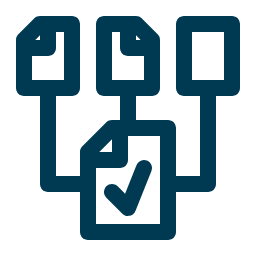
Advanced Sensor Data Integration & Transformation:
The suite integrates real-time data from various sensors mounted on the conveyor systems, capturing critical metrics such as belt tension, motor operation, and roller condition. This comprehensive monitoring and analysis allow for the identification of areas that require maintenance or operational optimization. The key benefit here is the provision of a holistic view of each conveyor system’s health, enabling timely interventions and preventing potential failures.

Predictive Analytics for Performance Enhancement:
Utilizing advanced predictive analytics, XMPro iBOS can forecast potential mechanical issues and identify optimal operational settings for each conveyor system. This predictive approach enables proactive adjustments to be made, enhancing the conveyor systems’ operational efficiency and reducing wear and tear. The primary benefit is the reduction in unplanned downtime and the extension of the conveyor systems’ operational lifespan.
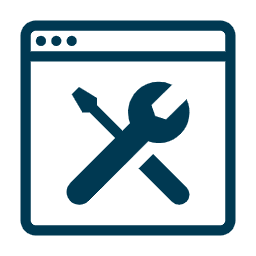
Maintenance Scheduling Optimization:
By analyzing performance data, XMPro iBOS helps shift maintenance strategies from a reactive to a predictive approach. This optimization of maintenance schedules is based on the actual condition of the equipment, rather than fixed intervals. The benefit is a significant reduction in downtime and an extension of the lifespan of conveyor system components, leading to increased overall efficiency and reduced maintenance costs.

Real-Time Monitoring and Predictive Alerting:
The platform generates automated recommendations for maintenance actions based on real-time data and predictive insights. This automation ensures that the conveyor systems are always operating at their peak efficiency and reduces the likelihood of unexpected failures. The key advantage is the ability to maintain continuous production flow, with minimal interruptions for maintenance.

Customizable and Interactive Dashboards:
XMPro iBOS features customizable dashboards that provide real-time insights into the performance of conveyor systems. These dashboards are interactive, allowing operators to drill down into specific aspects of conveyor system operation for a more detailed analysis. The benefit of these dashboards is that they enhance decision-making capabilities and allow for quick responses to emerging issues, ensuring optimal performance at all times.

Scalability and Flexibility – Start Small, Scale Fast:
XMPro iBOS offers scalable and flexible solutions that are suitable for different sizes of automotive manufacturing operations. This modular design ensures easy integration and adaptability, allowing operations to start small and expand as needed. The benefit here is the ability to scale the solution in line with the growth of the manufacturing operation, ensuring that the predictive maintenance system evolves with the business.

Enhanced Safety & Operational Efficiency:
The suite enhances operational safety by predicting and mitigating potential risks associated with conveyor system operation. It also improves overall operational efficiency by ensuring that the conveyor systems operate within optimal parameters. The key benefit is the creation of a safer working environment and the reduction of operational risks, leading to a more efficient and productive manufacturing process.

XMPro Blueprints – Quick Time to Value:
XMPro Blueprints offer a rapid path to value realization for automotive manufacturers. These pre-configured templates are designed for quick implementation, incorporating best practices and industry standards. The benefit of these Blueprints is that they accelerate the deployment process, enabling manufacturers to quickly realize the advantages of the predictive maintenance system.
In summary, XMPro iBOS addresses the Conveyor Belt System Monitoring and Optimization use case in the automotive industry by providing a comprehensive, real-time, predictive, and integrated solution. Its capabilities in digital twin technology, advanced data integration, predictive analytics, and interactive dashboards make it a powerful tool for enhancing the performance, safety, and efficiency of conveyor belt systems in automotive manufacturing.
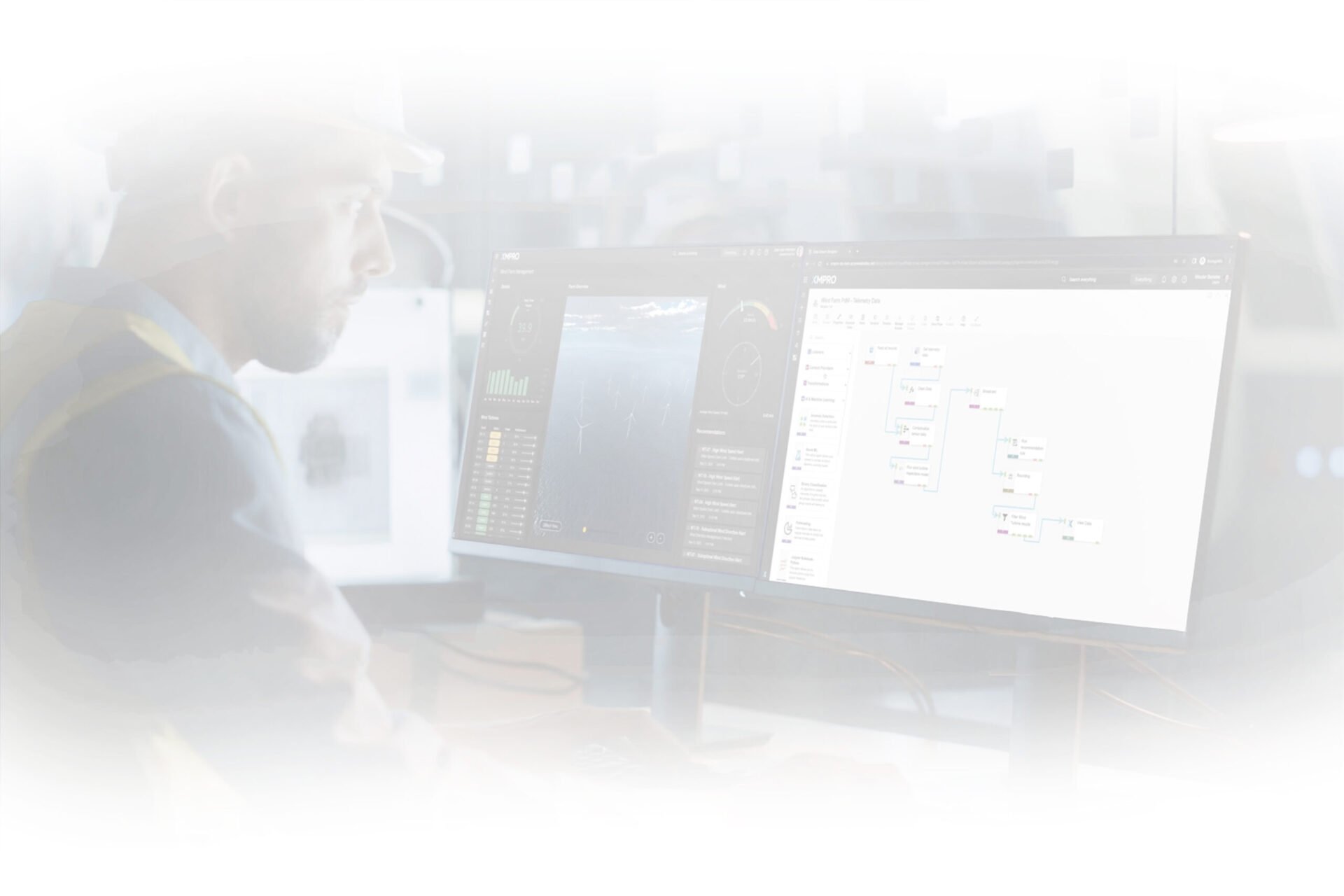
Not Sure How To Get Started?
No matter where you are on your digital transformation journey, the expert team at XMPro can help guide you every step of the way - We have helped clients successfully implement and deploy projects with Over 10x ROI in only a matter of weeks!
Request a free online consultation for your business problem.
"*" indicates required fields






